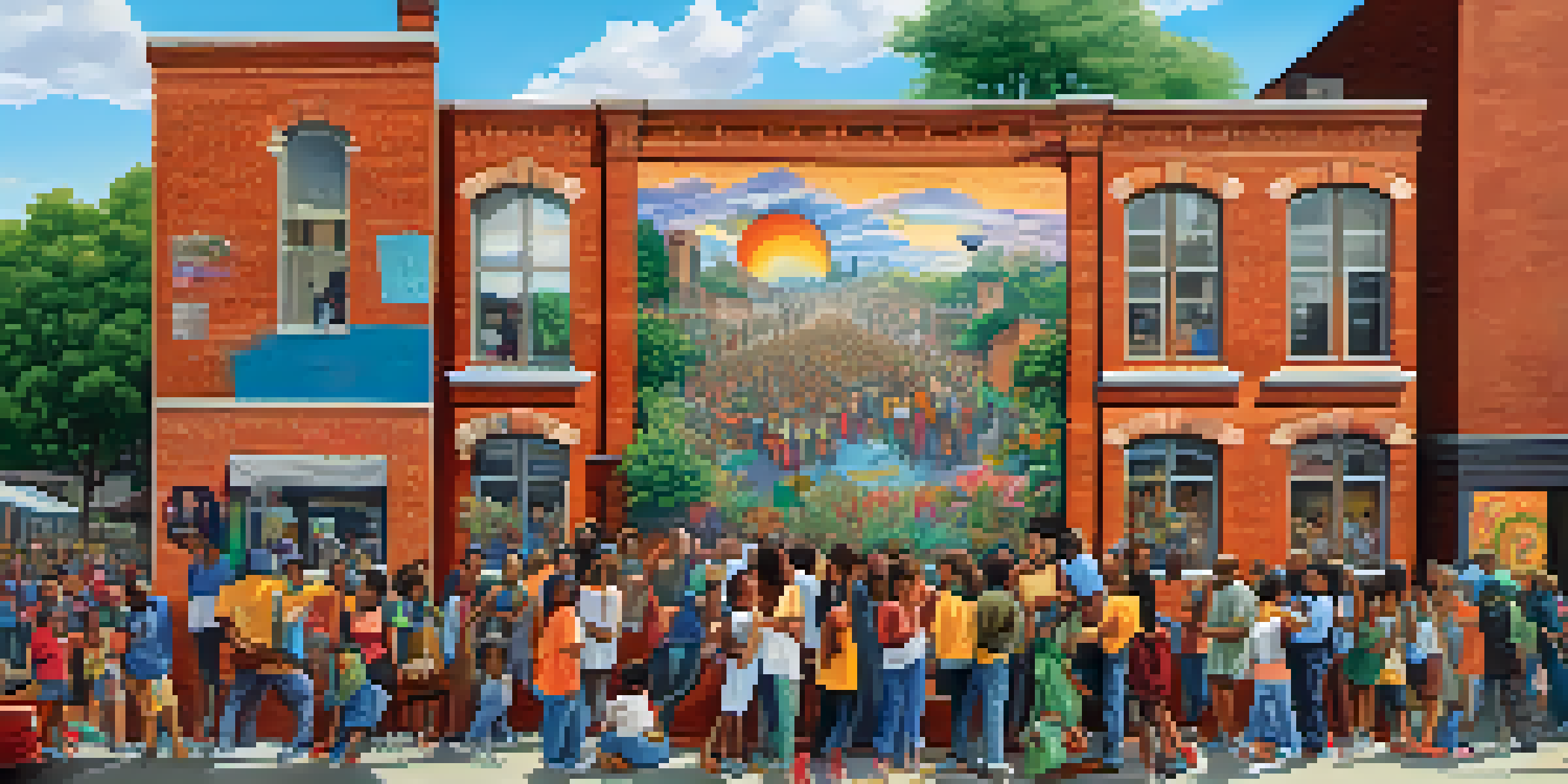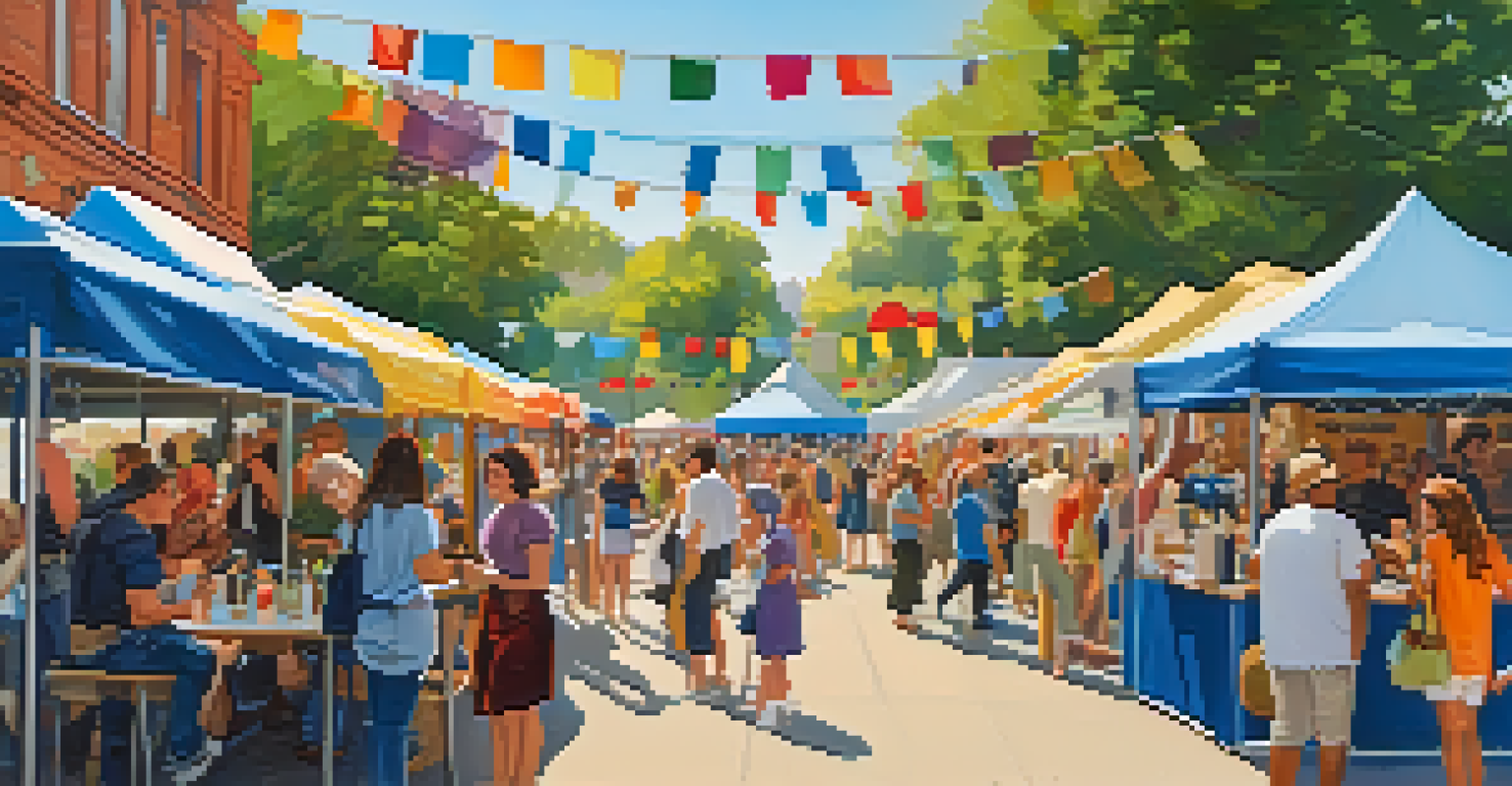Art as a Catalyst for Community Engagement and Healing

Understanding Art’s Role in Community Engagement
Art has a unique way of bringing people together, creating shared experiences that foster connection. By participating in artistic endeavors, community members can express their thoughts and emotions in a safe space. This collective engagement can lead to stronger bonds among individuals, which is essential for a thriving community.
Art is not freedom from discipline, but disciplined freedom.
When communities come together to create art, whether through murals, performances, or workshops, it cultivates a sense of belonging. Art can break down barriers, encouraging collaboration across diverse backgrounds and perspectives. This inclusivity not only enhances creativity but also enriches the community’s cultural fabric.
Moreover, art provides a platform for voices that may otherwise go unheard. By highlighting local issues through creative expression, artists can spark important conversations and inspire action. This dialogue is crucial for fostering understanding and solidarity within the community.
Art as a Means of Healing
Art therapy, a recognized form of healing, demonstrates how creative expression can alleviate emotional pain. Through various forms of art, individuals can process their feelings, confront trauma, and find solace. This therapeutic approach can be especially beneficial for those grappling with mental health challenges or past experiences.

Participating in art-making can also serve as a coping mechanism during difficult times. The act of creating allows individuals to channel their emotions into something tangible, offering a sense of control and purpose. This process can be incredibly liberating, helping people regain their sense of self and well-being.
Art Fosters Community Connection
Art brings people together, creating shared experiences that strengthen bonds and foster a sense of belonging.
Additionally, community art projects that focus on healing can bring people together to share their stories and experiences. This shared vulnerability not only fosters empathy but also allows for communal healing. When individuals witness others’ journeys through art, it can create a powerful sense of unity and support.
The Impact of Public Art on Communities
Public art installations, such as murals and sculptures, can transform ordinary spaces into vibrant community hubs. These artworks often reflect the culture and history of the area, instilling pride among residents. When art is accessible to all, it invites engagement and sparks curiosity.
The role of art is not a rarified, intellectual one; it is to help us see ourselves in the world and the world in ourselves.
Moreover, public art can serve as a visual representation of community values and aspirations. It can communicate messages of hope, resilience, and solidarity, which are vital during challenging times. By beautifying their surroundings, communities can foster a positive environment that encourages interaction and connection.
Events centered around public art, like unveilings or festivals, also promote community gathering. These occasions provide opportunities for residents to come together, celebrate local talent, and engage in meaningful conversations. Ultimately, public art nurtures a sense of place and belonging, making communities feel more cohesive.
Art Education as a Community Builder
Art education plays a crucial role in fostering creativity and collaboration within communities. By offering workshops and classes, organizations can provide opportunities for individuals of all ages to learn and express themselves. This educational aspect not only enhances artistic skills but also cultivates a supportive network of peers.
When community members engage in art education, they often develop a shared sense of purpose. Collaborating on projects, whether in schools or community centers, can strengthen relationships and build trust among participants. This camaraderie is essential for nurturing a vibrant, interconnected community.
Art as Healing and Empowerment
Creative expression through art provides a therapeutic outlet that helps individuals process emotions and promotes communal healing.
Furthermore, art education empowers individuals to become advocates for their community. As they learn to express themselves creatively, they may also become inspired to address local issues through their art. This empowerment can lead to a more engaged citizenry that actively participates in community development.
Art Festivals and Their Community Impact
Art festivals are a fantastic way to celebrate local talent while bringing community members together. These events often showcase diverse artistic expressions, from visual arts to music and performance. By participating in such festivals, residents can engage with one another in a joyful, creative atmosphere.
Moreover, art festivals contribute to the local economy by attracting visitors and promoting local businesses. Food vendors, artisans, and performers all benefit from increased foot traffic during these events. This economic boost can be a catalyst for further community development and investment in the arts.
Additionally, art festivals create opportunities for cultural exchange and understanding. When people from different backgrounds come together to celebrate art, they can share stories, learn from one another, and foster mutual respect. This cultural dialogue enriches the community and promotes a sense of unity.
The Role of Art in Social Movements
Art has long been a powerful tool for social change, allowing communities to express their struggles and aspirations. From protest songs to powerful murals, artistic expressions can amplify voices advocating for justice and equality. This visibility is essential for raising awareness and motivating action.
In community organizing, art can serve as a rallying cry, uniting individuals around a common cause. Creative campaigns often attract more attention and engagement than traditional messaging. By integrating art into social movements, communities can inspire passion and commitment among their members.
Public Art Enhances Local Identity
Public art transforms spaces and reflects community values, fostering pride and encouraging social interaction among residents.
Furthermore, art can help preserve the history of social movements, capturing the narratives of those involved. Documenting these stories through various art forms ensures that the struggles and victories of the past are not forgotten. This preservation is crucial for educating future generations and continuing the fight for justice.
Future Directions for Art and Community Engagement
As we look to the future, the integration of technology in art offers exciting possibilities for community engagement. Virtual reality, digital art, and online platforms can connect people across geographical boundaries. This accessibility allows for a broader range of participation and collaboration.
Moreover, the rise of social media has transformed how art is shared and experienced. Communities can now showcase their artistic endeavors to a global audience, attracting support and recognition. This online presence can encourage more people to get involved and contribute to local art initiatives.

Ultimately, the future of art as a catalyst for community engagement and healing lies in continued innovation and collaboration. By embracing new technologies and fostering inclusive spaces for creativity, communities can thrive and heal together. The journey ahead is bright as we harness the power of art to connect, support, and inspire one another.